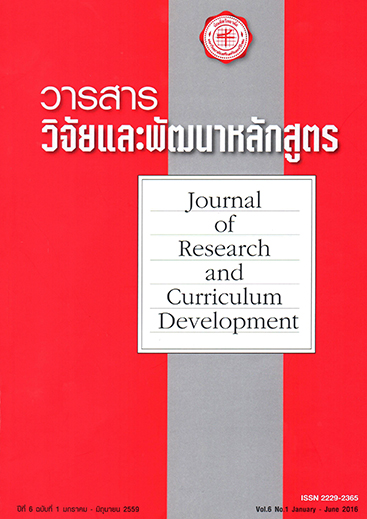การพัฒนาเครื่องมือวัดความสามารถในการใช้เทคโนโลยีสำหรับนักเรียนชั้นประถมศึกษาปีที่ 6 ในโรงเรียนสังกัดกรุงเทพมหานคร
Keywords:
เครื่องมือวัด, ความสามารถในการใช้เทคโนโลยี, ประถมศึกษา, Measuring Instrument, Technology Literacy, PrathomSuksaAbstract
การวิจัยนี้มีวัตถุประสงค์เพื่อสร้างและตรวจสอบคุณภาพเครื่องวัดแบบความสามารถในการใช้เทคโนโลยี สำหรับนักเรียนชั้นประถมศึกษาปีที่ 6 ในโรงเรียนสังกัดกรุงเทพมหานครกลุมตัวอย่างที่ใช้ในการวิจัย ได้แก่ นักเรียนชั้นประถมศึกษาปีที่ 6 ในโรงเรียนสังกัดกรุงเทพมหานคร ปีการศึกษา 2557 จำนวน 450 คน ได้มาจากการสุ่มแบบหลายขั้นตอน เครื่องมือวัดความสามารถในการใช้เทคโนโลยีที่สร้างขึ้นประกอบด้วยแบบทดสอบ 2 ฉบับ คือ ฉบับที่ 1 แบบทดสอบความรู้เกี่ยวกับการเลือกและใช้เทคโนโลยี และฉบับที่ 2 คือ แบบทดสอบทักษะกระบวนการทางเทคโนโลยี สถิติที่ใช้ในการวิเคราะห์ข้อมูล ได้แก่ ดัชนีความสอดคล้อง ความยาก อำนาจจำแนก ความเที่ยงโดยใช้สูตรของคูเดอร์ และริชาร์ดที่ 20 (KR–20) และสัมประสิทธิ์สหสัมพันธ์แบบเพียร์สัน ผลการวิจัย พบว่า เครื่องมือวัดความสามารถในการใช้เทคโนโลยี สำหรับนักเรียนชั้นประถมศึกษาปีที่ 6 โรงเรียนในสังกัดกรุงเทพมหานคร ประกอบด้วย แบบทดสอบ 2 ฉบับคือ ฉบับที่ 1 แบบทดสอบความรู้เกี่ยวกับการเลือกและใช้เทคโนโลยี เป็นแบบเลือกตอบชนิด 4 ตัวเลือก จำนวน 20 ข้อ มีค่าความตรงโดยดัชนีความสอดคล้อง ระหว่าง 0.60 ถึง 1.00 ความยากมีค่าระหว่าง 0.36 ถึง 0.76 อำนาจจำแนกมีค่าระหว่าง 0.21 ถึง 0.56 มีค่าความเที่ยง เท่ากับ 0.88 ฉบับที่ 2 แบบทดสอบทักษะกระบวนการทางเทคโนโลยีแบ่งเป็น 2 ตอน ตอนที่ 1 กระบวนการแก้ปัญหาทางเทคโนโลยี เป็นข้อสอบแบบสถานการณ์ จำนวน 20 ข้อ มีค่าความตรงโดย ดัชนีความสอดคล้อง ระหว่าง 0.80 ถึง 1.00 ความยากมีค่าระหว่าง 0.34 ถึง 0.71 อำนาจจำแนกมีค่าระหว่าง 0.21 ถึง 0.56 ค่าความเที่ยงเท่ากับ 0.90 และตอนที่ 2 ทักษะปฏิบัติทางเทคโนโลยี เป็นแบบประเมินรูบริค 4 ระดับ จำนวน 10 ข้อ มีค่าความตรงโดยดัชนีความสอดคล้อง เท่ากับ 1.00 ทุกข้อ มีค่าความเที่ยงเท่ากับ 0.85
Development of Instruments to Measure Technology Literacy of PrathomSuksa VI Students in Schools Under Bangkok Metropolitan Administration
The objective of this research was to develop and validate the quality ofinstruments for measuring technology literacy of PrathomSuksa VI students in schoolsunder Bangkok Metropolitan Administration. The sample consisting of 450 students insuch schools was obtained by a multi-stage sampling technique. The developed andvalidated instruments for the measurement comprised two tests. One was used tomeasure the studentsû knowledge of technological selection and usage. The other wasused to measure their process skills in technology. The statistical tools for analyzingcollected data are index of congruence (IOC), difficulty index, discrimination index, KR-20 for reliability coefficient index, and Pearsonûs correlation coefficient index. Thefindings reveal that the instruments to measure the technology literacy of the studentscomprised two tests. One was a set of 20 items of multiple choice questions with fourpossible answers regarding the studentsû knowledge of technological selection andusage. The IOC of the items ranged from 0.60 to 1.00, the difficulty index ranged from 0.36 to 0.76, the discrimination index ranged from 0.21 to 0.56, and the reliabilitycoefficient index was 0.88. The other was a two-part test regarding the student's processskills in technology. Part one was to measure the studentsû technological problemsolving process, consisting of 20 situational items. In this part, the IOC ranged from 0.80 to 1.00, the difficulty index ranged from 0.34 to 0.71, the discrimination indexranged from 0.21 to 0.56, and the reliability coefficient index was 0.90. Part two wasto measure the studentsû technological practice skills in a 4-level rubric evaluationform and consisted of 10 items, each of which yielded the IOC of 1.00. The reliabilitycoefficient index of this part was 0.85.





